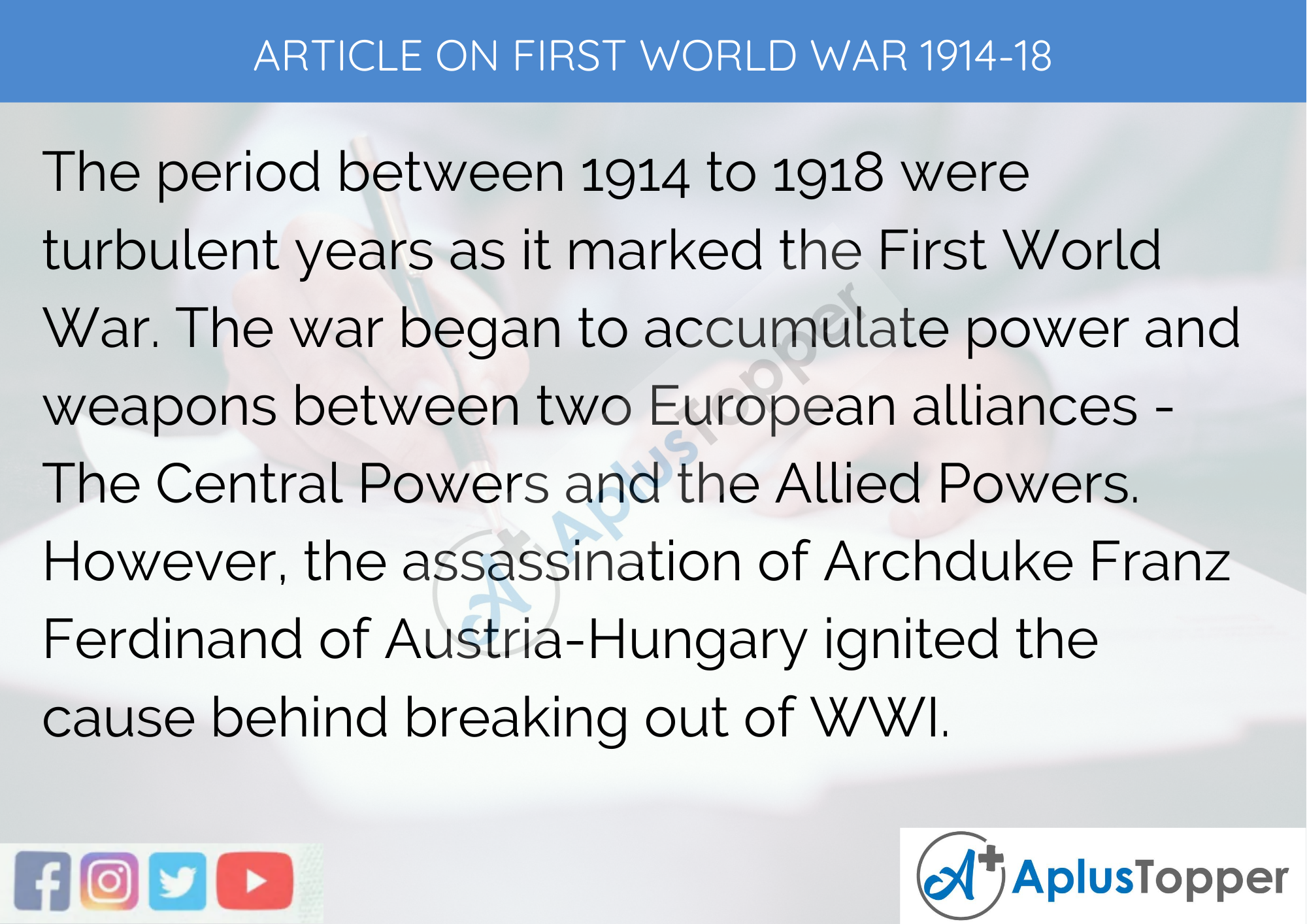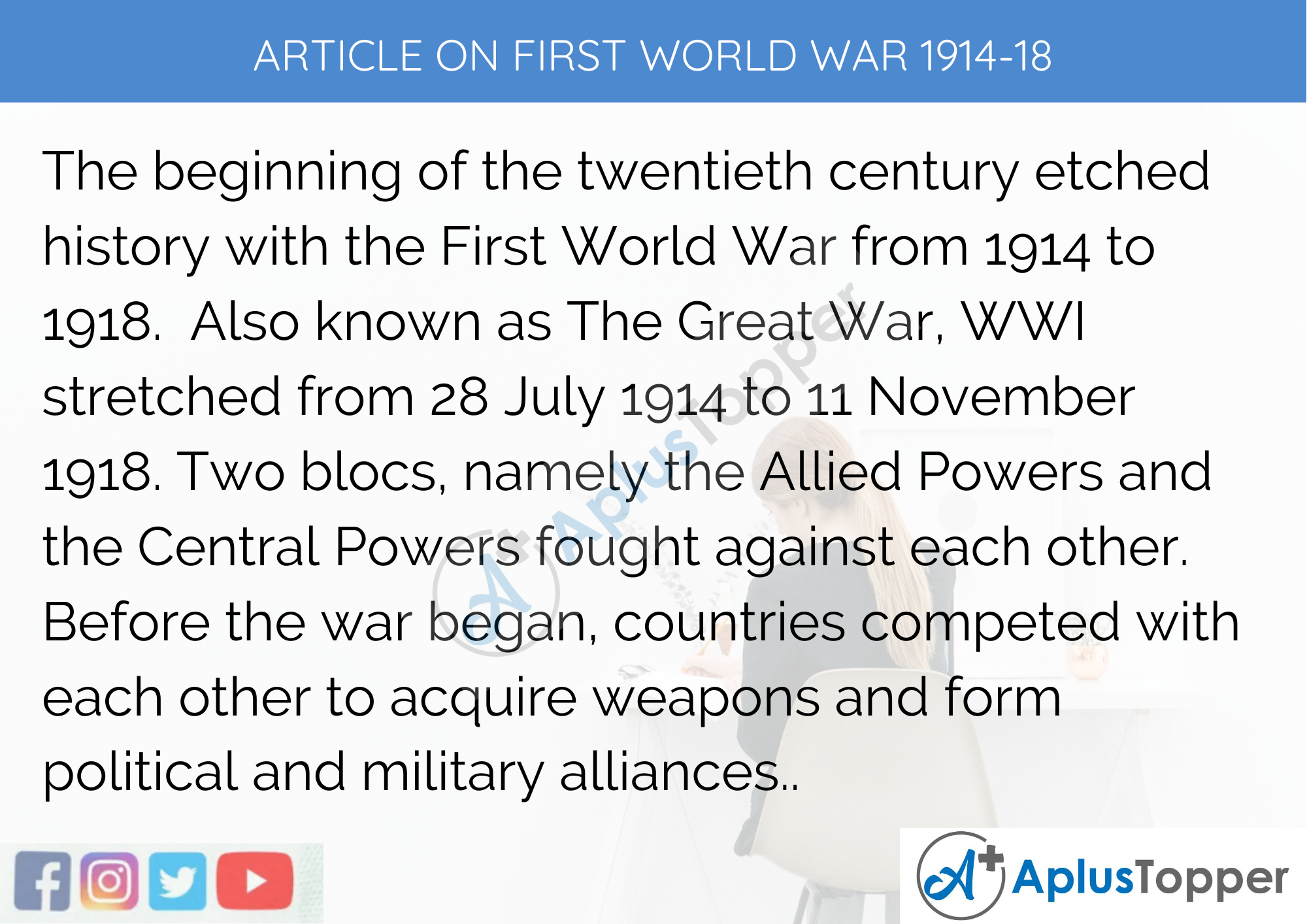Article on First World War 1914-18: Wars are destructive. They not only kill but also bring about long-term damage to the human race. The First World War is proof of the clashes among several countries around the globe. The War killed approximately 20 million people and put a dent in the economic development of several nations. The First World War took place between two parties consisting of more than one hundred countries. Though all of them did not send troops to the battlefield, they were reservoirs of commodities and human resources and provided moral support to their allies. It continued for four long years from 1914 to 1918.
You can read more Article Writing about people, sports, technology many more.
Long and Short Articles on the First World War 1914-1918 in English for Students and Children
Here, you will find two types of articles on the topic of the first World War 1914-18. The first is a long article, which consists of 400 – 500 words. On the other hand, the second article is a short one comprising 200 words. The lengthy article is useful for students preparing for competitive examinations, assignments, etc. Furthermore, teachers can also use this as a base to help children develop extra-curricular activities, such as debates, speeches, article writing, etc. The short article for 200 words is an excellent piece for children and kids. It will assist them with their projects, assignments, class activities, etc.

Long Article on First World War 1914-18 in English 500 Words
The lengthy article given below on the first World War 1914-18 is useful for aspirants of competitive exams. It is suitable for students studying in classes 6, 7, 8, 9, and 10. With this article’s help, children can make progress in their classwork, home assignments, reading and writing comprehension, article writing tasks, and preparation for competitive examinations. Long Article About the First World War 1914-1918 in English for Students of Classes 6, 7, 8, 9, and 10.
The period between 1914 to 1918 were turbulent years as it marked the First World War. The war began to accumulate power and weapons between two European alliances – The Central Powers and the Allied Powers. However, the assassination of Archduke Franz Ferdinand of Austria-Hungary ignited the cause behind breaking out of WWI. The Central Powers include countries, such as Germany, Bulgaria, Austria-Hungary, Ottoman Empire, and Turkey. On the other hand, the Allied Powers consisted of Serbia, Russia, The United Kingdom, France, Italy, Japan, and Belgium. India, as a British colony, supported Britain. The United States of America joined in later in 1917.
The Beginning of World War I
Gavrilo Princip from Serbian assassinated the heir of the Austro-Hungarian Empire, Archduke Franz Ferdinand, and his wife in June 1914 to end the dominion of Austro-Hungarian Empire. The chain of events began when Austria-Hungary declared war. Germany came to extend support to Austria-Hungary. Eyeing danger, the Serbian government turned to the Russian allies to retaliate.
The German adopted a militaristic Schlieffen approach and began fighting on the eastern and western front. It aggressively responded to the Russian army in the east and conspired to acquire France in the west. The French and British forces successfully counterattacked the Germans and drove them back. At the western front, the German forces did not give up, which led to the Trench War between German and France. The armies fought in trenches dug into the ground along the eastern stretch of France, leaving enormous civilian and military casualties. The Russian army lost miserably in Germany and Austria during 1914-1916. However, while leaving, the Russian army left a devastating piece of farmland and collapsed buildings to cripple the enemy. This led to food scarcity, a rise in poverty, and economic instability. The situation disreputes the Tsar and soldiers’ discontentment surged.
The Impact of World War I
The First World War had a severe impact on industrialization as the supply chain was broken. The German dominated the Baltic Seas, which was the sea-route for industrial goods to Russia. The railway lines were uprooted. Labour-associated industries were hit hard due to the lack of human resources. Production of essentials was closed down. Grains were reserved for armies, which created a shortage of food items for civilians. As a result, bread became a rare commodity in cities, and riots broke out. All this mounted up to explosion of the Russian Revolution in 1917. It brought an end to the czarist rule of Vladimir Lenin. Russia exited from World War I.
Initially, the United States remained aloof from participating in WWI. However, Germany continued to sink U.S. ships in waters surrounded by the British Isles as the war zone. When hundreds of American passengers onboard became the victim of German U-boats, and several U.S. merchant ships sank, Woodrow Wilson declared war against Germany. Machine guns, heavy artillery, tanks, and poison gas were also used in the war
The End of WWI
When the resources became scarce and soldiers limited, the war fizzled out. In November 1918, Germany signed a peace treaty with the Allied Powers, which emerged victoriously. Both powers ended the conflict by signing the armistice agreement.
Short Article on First World War 1914-18 in English 200 Words
The article of 150 – 200 words is a short piece for kids and children studying in standard below 6. They can use this as a guide to help them with classwork, reading comprehension, writing skills, and school assignments. Short Article About the First World War 1914-18 for Children Studying Classes 1,2,3,4,5 and 6.
The beginning of the twentieth century etched history with the First World War from 1914 to 1918. Also known as The Great War, WWI stretched from 28 July 1914 to 11 November 1918. Two blocs, namely the Allied Powers and the Central Powers fought against each other. Before the war began, countries competed with each other to acquire weapons and form political and military alliances. On 28th June 1914, Serbia assassinated Archduke Franz Ferdinand, the heir of Austria-Hungary throne. An uproar of war was declared in Austria-Hungary against Serbia. Other countries joined in and defended their allies. Different countries fought against different allies. The situation in Europe was tense as the battle was fought on the east and the west.
Along the western front, France and Belgium were invaded by German military troops. Along the eastern front, Russia was attacked. When Germans troops found themselves losing, the war was fought from tunnels dug in the ground. That is why the First World War is also called Trench War. Extensive uses of artillery, machine guns, tanks, poisonous gas, U-boats, etc. were used. As a result of which many women and children, apart from soldiers, died in the war. Indian soldiers also participated in the First World War as a colony of Britain from Africa and West Asia. India hoped that they might win independence. The war brought down the economy of the world. It led to food scarcity, an outbreak of a pandemic, scarcity of essential commodities, etc. The war came to an end towards the end of 1918. The Allied Powers won the war. Both parties signed the Peace Treaty known as an armistice.

10 Lines on First World War 1914-18
- The First World War was instigated in 1914 by Serbia.
- The cause of war was a competition between countries to acquire weapons, and build military powers.
- In 1914, Serbia aroused anger by assassinating Archduke Franz Ferdinand, the heir of Austria-Hungary throne.
- Two blocs, namely the Allied Powers, and the Central Powers fought against each other.
- The Central Powers include countries, such as Germany, Bulgaria, Austria-Hungary, Ottoman Empire, and Turkey.
- The Allied Powers consisted of Serbia, Russia, The United Kingdom, France, Italy, Japan, and Belgium.
- India, as a British colony, supported Britain. The United States of America joined in later in 1917.
- The German adopted a militaristic Schlieffen approach and began fighting on the eastern and western front.
- The First World War or WWI or The Great War was fought from trenches, so it is also called the Trench War.
- The War left enormous devastation when it ended in 1918 after both allies signed an armistice.
FAQ’s on Article on First World War 1914-18
Question 1.
List the names of the two allies of the First World War 1914-1918.
Answer:
Two blocs, namely the Allied Powers and the Central Powers fought against each other in the First World War.
Question 2.
Who declared the First World War?
Answer:
When Serbia killed Archduke Franz Ferdinand, Austria-Hungary announced war against Serbia. In August 1914, Germany attacked Russia and France. Britain fought Germany, then Austria counterattacked Russia.
Question 3.
Name the countries of Allied Powers.
Answer:
Britain, Japan, France, Italy, Russia, the USA were the Allied Powers.
Question 4.
Why did the First World War end?
Answer:
The First World War ended in November 1918 when both allies signed the Peace Treaty known as an armistice.
